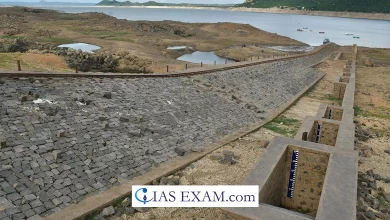UPSC Editorial Analysis
A Path to Global Connectivity
[GS Paper 3 – Awareness In The Fields Of It, Space, Computers, Robotics]
Context – As terrestrial 5G mobile networks are being rolled out across countries, there is a renewed interest in integrating Non-Terrestrial Networks.
About SatNets for 5G
- Satellites and terrestrial networks have always been considered two independent ecosystems, and their standardization efforts have proceeded independent of each other.
- The primary non-terrestrial network that is being considered is the low latency Low Earth Orbit (LEO) satellite networks (SatNets), as a complement to terrestrial networks.
- Towards this, Starlink, operated by the Elon Musk-owned SpaceX, and OneWeb, promoted by Bharti Global, have launched about 2,500 and 648 LEO satellites respectively at an altitude of about 1,200 km with the objective of promoting global broadband connectivity.
- There are other players such as Reliance Jio in a joint venture with Luxembourg-based SES and Amazon’s Project Kuiper.
Benefits of using SatNets
- Service continuity in emergency: service continuity to provide seamless transition between terrestrial networks and SatNets in case of public safety, disaster management and emergency situations;
- Providing service in remote area: Service ubiquity to provide 5G services in unserved and underserved areas of the world, thereby bridging the digital divide;
- Scalability: Service scalability that utilizes the unique capabilities of SatNets in multicasting and broadcasting similar content over a large geographical area.
- Service to in-motion users: The LEO SatNets can provide service not only to stationary but also to in-motion users.
- Low latency over long distance: Wireless communications through LEO satellites over long distances is proven to be 1.47 times faster than communication over the same distance through terrestrial optic fibre. It is this advantage along with global coverage that provide a strong use case for LEO SatNets to complement terrestrial optic fiber networks.
- SatNet in standardization: In view of the above advantages, standard-setting organizations such as the Third Generation Partnership project (3GPP), comprising telcos and equipment manufacturers around the world, started integrating SatNets in the standardization process.
Measures by the Government
- Realizing the advantages, the Government, in its National Digital Communications Policy 2018, has indicated the development of an ecosystem for local manufacturing of satellite communication systems and promoting participation of private players for the strengthening of satellite communication infrastructure in the country.
- Accordingly, the New Space India Limited (NSIL), a public sector enterprise, was established in 2019 to reorient space activities from a ‘supply driven’ model to a ‘demand driven’ model, thereby ensuring optimum utilization of the space assets.
- The Department of Space also established in 2020 a new regulatory body named the Indian National Space Promotion and Authorisation Centre (IN-SPACe).
- IN-SPACe is intended to provide a level playing field for private companies to use Indian space infrastructure.
Issues and challenges
- Allocation of frequency: Issues will involve addressing issues around frequencies to be allocated for satellite broadband, the methodology of allocation, the relatively higher cost of consumer equipment and the placement and interconnections of SatNets with terrestrial public landline/ mobile networks at the ground stations
- Cost: The other major challenge in LEO SatNets is the cost of user terminal and access charges to the end users.
- A recent research analyzing both Starlink and OneWeb concludes that the standalone LEO SatNets have a distinct cost advantage only if the density is less than 0.1 person per square km compared to terrestrial broadband networks.
- Hence it is to the advantage of LEO SatNet providers to integrate their networks with terrestrial 5G networks to improve the cost economies.
Conclusion
All these, along with the proposed revisions to the Satellite Communications Policy of the Government, will provide the required fillip to LEO SatNets to become an integral part of the communication infrastructure of the country.





.png)



